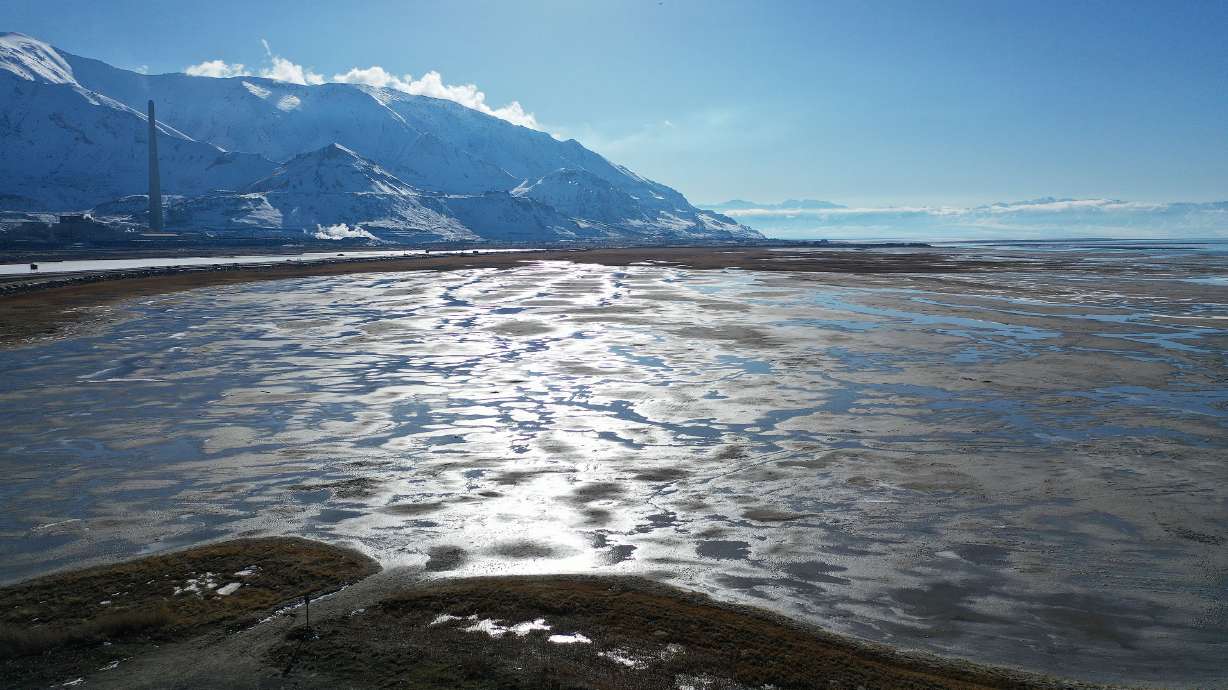SALT LAKE CITY — A team of Utah agencies and research institutions outlined six "major" recommendations for the state to consider when it comes to handling the drying Great Salt Lake.
But failing to address the lake's decline poses threats to public health and economic activity in Utah in addition to the ecosystem that relies heavily on it, members of the Great Salt Lake Strike Team wrote in their first policy report issued Wednesday. The report urges the state to act quickly because the lake has already fallen to levels that could come with "serious adverse effects."
"Our findings are both stark and hopeful. We firmly believe Great Salt Lake can be saved but it will require state leadership, research university technical expertise, and individual and collective action," said strike team co-chairs Brian Steed and Bill Anderegg, the directors of the Janet Quinney Lawson Institute for Land, Water, and Air at Utah State University the Wilkes Center for Climate Science and Policy at the University of Utah, in a joint statement.
The team, which is composed of leaders and researchers from the Utah departments of agriculture, environmental quality and natural resources, as well as researchers at the University of Utah and Utah State University, said the state can start by taking advantage of this winter's above-normal snowpack. This year's snowpack is still forecast to end up between 110% and 130% of normal, according to the Utah Division of Water Resources.
"The current wet year offers a significant opportunity to make progress on the lake elevation. Do not miss this opportunity," the team wrote in the report.
Their five other recommendations are:
- Set a lake elevation range goal between 4,198 feet and 4,205 feet elevation. Sen. Nate Blouin, D-Salt Lake City, proposed a resolution that would set a goal of 4,198 feet elevation, but members of the Senate Natural Resources, Agriculture and Environment Committee voted to hold the resolution during a hearing last week.
- Invest in water conservation to increase inflows or decrease withdrawals from the lake. The Utah Legislature's $40 million trust is expected to begin seeking inflow additions this year.
- Invest in water intelligence monitoring and modeling, so the state can be "more responsive and effective to challenges." The team recommends that the state double its current investment in "accurate and timely measurements and forecasts."
- Develop a long-term water resource plan for the Great Salt Lake watershed basin to "ensure a resilient water supply for all water users in the basin, including Great Salt Lake." The Utah Department of Natural Resources is currently developing this.
- Request in-depth analyses on policy options, so that the Utah governor and Legislature can direct the Great Salt Lake Strike Team to study the most water-efficient, cost-effective and high-return options.
The strike team's goal is to research issues tied to the Great Salt Lake to suggest new ways for Utah to improve the lake's watershed and increase the lake's water levels, which reached an all-time low for the second-straight year in 2022.
"The strike team quickly synthesizes cutting-edge research and delivers information to those who need it most," the team's seven co-chairs wrote in the report. "It includes top researchers from Utah's research universities who are experts in public policy, hydrology, water management, climatology and dust."
How the lake fell
The Great Salt Lake has experienced ups and downs ever since levels were first tracked in 1847. But the report lists 4,192 feet elevation as the point where "serious adverse effects on brine shrimp viability, air quality, mineral production and recreation" are possible. The lake crossed that line in 2021, continuing to fall to a record low of 4,188.6 feet on Oct. 27, 2022. It has risen some since but remains below this target.
So how did this happen?
The team says consumptive use is by far the leading factor, accounting for anywhere from 67% to 73% of the lake's decline. It towers over other detractors like natural variability, or the uncertainty of snowpack collection and snowmelt runoff, which accounts for anywhere from 15% to 23% of the decline, or direct evaporation, which accounts for 8% to 11% of the lake's water loss, according to the report.
Projects that divert water from the lake's tributaries are a major reason why water isn't going to the Great Salt Lake, the report adds. The Bear, Jordan and Weber rivers account for nearly 95% of the lake's water; however, not as much of the water of those tributaries is ending up in the lake.
"Even though overall water supply from the mountains shows no long-term trend, inflow to the lake is decreasing. This decrease reflects greater depletion by natural and human systems at lower elevations," the report states.
What can help solve the problem?
The team also analyzed some of the early proposed solutions to fix the lake's issues, based on benefits, costs and challenges, and feasibility.
For example, importing water to the Great Salt Lake through a pipeline could bring 500,000 acre-feet of water every year, making it the best option in terms of benefits. However, the team notes it also notes that such a project would be "expensive, slow and controversial," likely costing more than $100 billion and taking decades to complete.
They contend the Great Salt Lake Trust and optimizing agriculture water use are more feasible options. Neither project would bring in as much water as a pipeline but both rank much higher in feasibility, and would still bring in more water than ideas like optimizing mineral extraction water use, cloud seeding or thinning the forest trees in the Great Salt Lake watershed.
The other benefit is that both are already in motion. The Utah Legislature allocated a record $70 million to the Utah Department of Agriculture and Food's Water Optimization Program in the 2022 legislative session, and $40 million to the trust.
The report finds that agriculture optimization can reduce water use by 10% to 15%. About 180,000 acre-feet of water would be saved every year if all agricultural use was cut by 15%. One acre-foot of water equates to about 325,851 gallons of water.
Meanwhile, they find there is a potential to lease 200,000 to 300,000 acre-feet of water through the Great Salt Lake Trust. The program allows for water rights owners to lease their rights so the water flows into the Great Salt Lake without the owner losing their rights permanently. It just requires anyone with water rights to agree to lease their rights.
Members of the team are scheduled to talk about the report's findings Wednesday morning.
This story will be updated.








